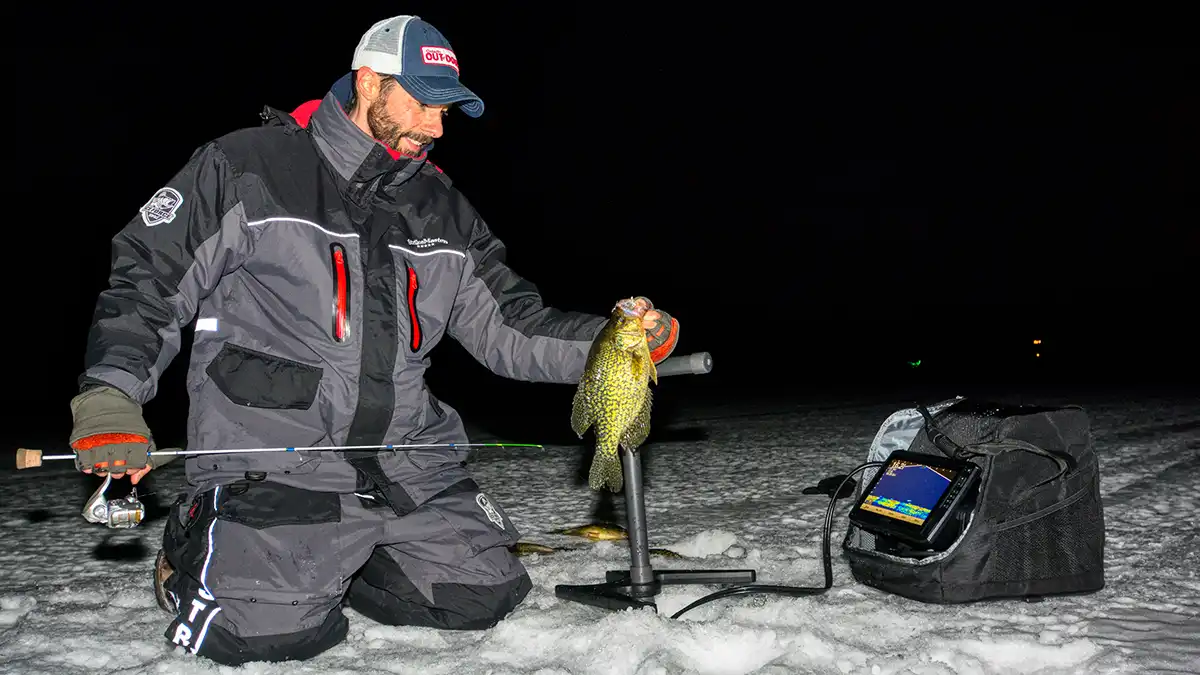Adopting an Ice-Fishing-101 approach, we compiled all the important information you need to know to stay safe and catch walleye, crappie, yellow perch, northern pike, trout and more. The first section explains some ice fishing tips and basics beginners need to understand before their first outing. The second section discusses some fundamental ice fishing tactics and presentation techniques.
The main aspects to consider in ice fishing include the following:
- Ice fishing safety
- Dressing for ice fishing
- Essential ice fishing equipment
- The best times to ice fish
- Popular ice fishing target species and where to find them
- Jigging tactics
- Tip-up tactics
- Best baits for ice fishing
Ice Fishing for Beginners
Is Ice Fishing Easy? This is a common question for beginners. The answer is somewhat of a yes-and-no scenario.
Yes, ice fishing can be easy. When ice conditions allow for easy travel and you find fish quickly, you can sometimes — quite literally — sit overtop of a school of fish and catch one after another. You also only need a few gear essentials to get started.
On the other hand, ice fishing is challenging at times. Trudging through deep snow on foot is hard work. Also, fish can concentrate in certain areas in winter and, as such, it can take time to find them. More, certain fish, like crappie and trout, can be notoriously fickle biters. Like any type of angling though, part of what makes ice fishing fun is overcoming the day’s challenges and successfully finding and catching fish.
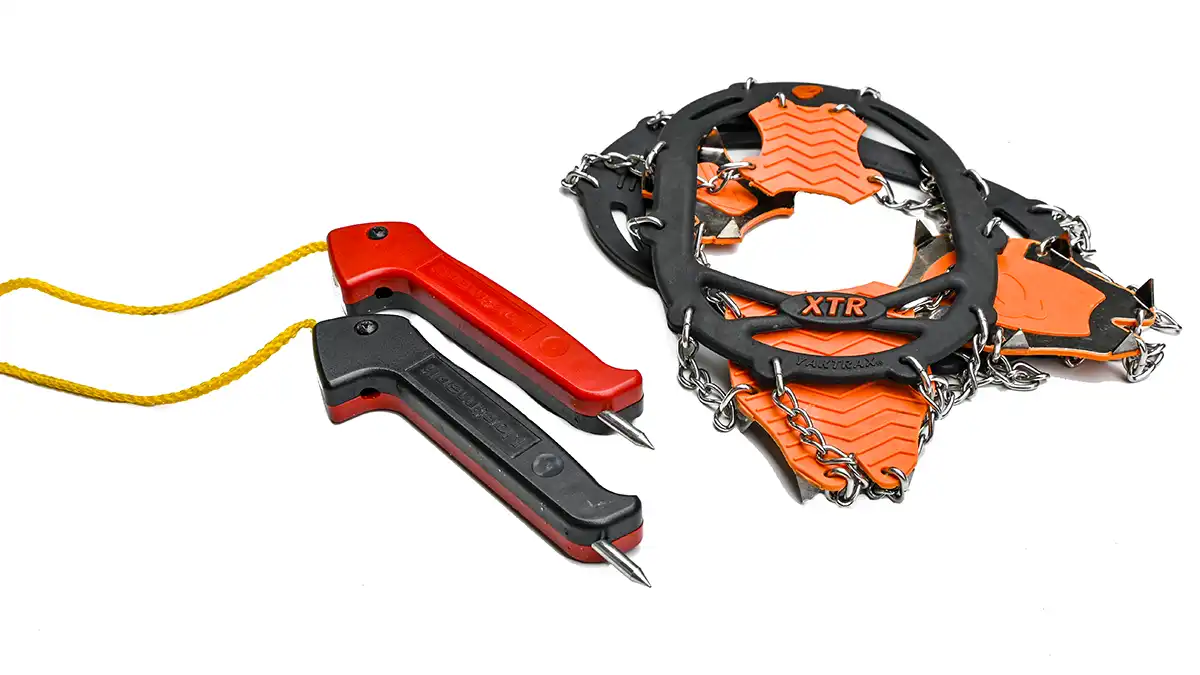
Ice Safety
Ice fishing safety should always be your number one priority ice fishing. The cold, harsh reality is ice is never 100% safe. Ice conditions will vary on a waterbody. Ice doesn’t freeze at a consistent thickness. Current, temperature, freeze-thaw cycles, pressure cracks, snow cover and old ice holes are just a few variables impacting ice conditions.
It’s critical to check ice conditions and thickness to determine whether they are favorable for ice fishing. Begin by checking the ice close to shore by drilling a hole with an ice auger (or chipping one with an ice chisel), then using a tape measure, or ice scoop with a ruler on its handle, to measure it. If you assess the ice quality and thickness are good, continue towards your fishing spot, frequently measuring ice thickness along the way.
The following ice thickness chart summarizes general guidelines of minimum ice thickness for new, solid, clear ice found on several State DNR websites. Note, layered and honeycombed ice, along with a snow-ice mix, are weaker and unable to support as much weight.
- Under 4 inches — stay off
- 4 inches — minimum for ice fishing on foot
- 5 to 7 inches — one snowmobile or ATV
- 8 to 12 inches — one car or small pickup truck
- 12 to 15 inches — one medium truck
** These are not hard fast rules. Always make your own determinations on ice thickness and safety for yourself in every case. Never go by second-hand reports or guesses.
11 More Ice Safety Suggestions
- A good safety practice, especially early and late in the season, is stabbing the ice in front of you with a spud bar (aka ice chisel) when walking on the ice. If the chisel goes through, you’re on thin ice! Go back the way you came.
- Spread out; clustering together can put too much weight in one area.
- Stay away from water inflows and outflows, and be extremely cautious about ice fishing rivers.
- Wearing a life jacket, floatation suit or ice-fishing jacket-and-bib combo with floatation properties is recommended. Should you fall through, the floatation will help keep your head above water and assist in performing a self-rescue.
- Ice picks are essential, providing extra traction on ice when held in the hands during a self-rescue.
- Boot cleats are must-haves for maintaining sure footing on slick, glare ice.
- Learn about frostbite risks, and dress and cover skin appropriately.
- Don’t ice fish alone.
- Phoning a fishing tackle shop or outfitter is a good way to get some intel on local ice conditions, but always check the ice yourself upon arrival as described above.
- 10.Leave an itinerary detailing your ice fishing trip with someone at home.
- Carry a spare change of clothes.
Before leaving the topic of ice safety, it’s important you understand the above information is a high-level overview of just a few ice safety considerations. We simply don’t have the space to get into all the details here, nor is doing so this article’s purpose. Also, while I’ve been ice fishing for more than 30 years and have written a book on the subject, I am not an ice safety expert/authority.
Ultimately, the onus rests on each of us to be well informed on the various elements of ice safety and be responsible for our own personal safety. State DNR and water safety organization websites are good places to learn more on the subject. Please always exercise caution, use common sense and don’t take risks.
Ice Fishing Apparel
One of the best ways to stay comfortable when ice fishing is dressing in layers with moisture-wicking clothing. This lets, you remove or add insulating layers as needed to regulate temperature and stay comfortable. Layering is important because ice fishing often involves a mix of being stationary and sitting around in the cold, combined with periods of exertion, such as walking through snow to get to a spot and drilling holes.
As far as outerwear, beginners can get by ice fishing with a warm winter jacket and insulated pants. Eventually, you’ll probably want a feature-loaded, ice-fishing suit, such as those from Clam, Eskimo, StrikeMaster, Striker and Vexilar.
Warm, waterproof insulated winter or hunting boots are a must-have. As are thick, warm socks. Other important items include an insulated hat, balaclava, gloves and mitts.
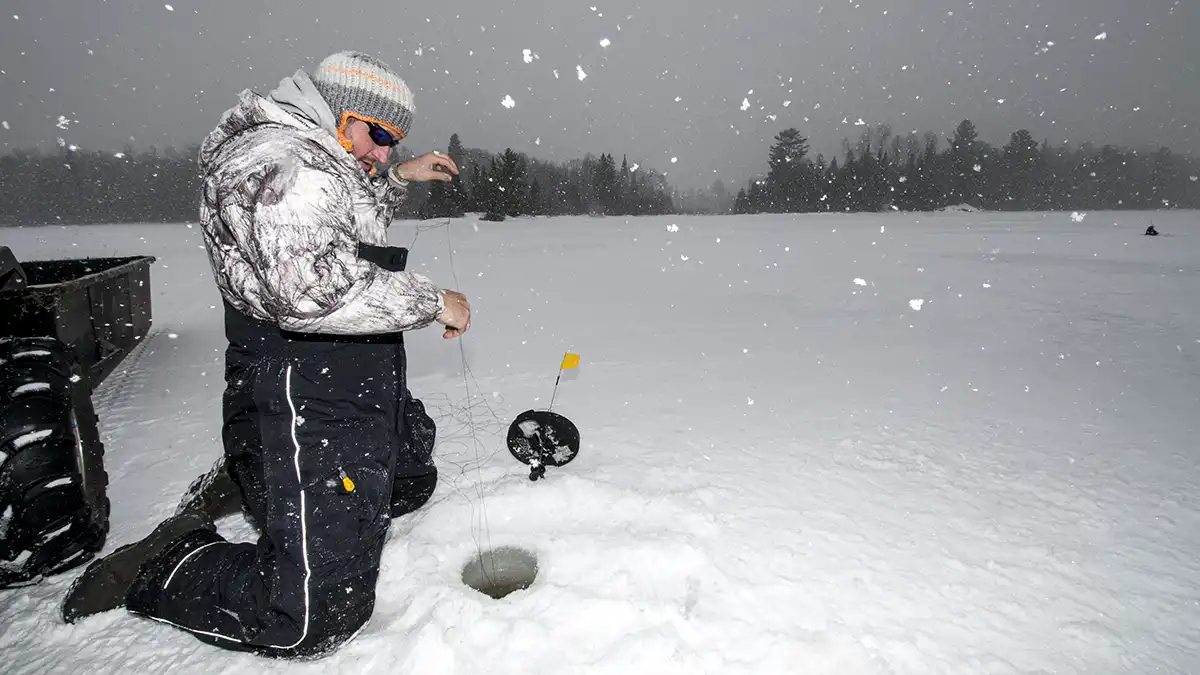
Essential Ice Fishing Equipment
There’s a lot of ice fishing gear out there, which we’ll discuss in-depth in our Ice Fishing Essential Gear article. For now, here’s a brief rundown of some necessities.
Ice Augers
You or one of your angling buddies will need an ice auger for drilling holes. Hand augers are light and affordable, but become difficult to use as ice thickness increases over winter. Power ice drills are heavier and more expensive, but cut through ice fast and do the work for you.
Fish Finder for Ice Fishing
A portable fish finder helps find fish and keep your bait around fish more often. It displays your lure as it moves in the water and how fish react to the presentation.
Rod and Reel Combos
Jigging is the most popular technique, so you’ll want at least one ice fishing jigging set-up. Spinning rod and reel combos are great for beginners. Examples of what these ice fishing setups might look like are an ultra-light rod and 2-pound monofilament for finessing panfish and a medium-light rod with 6-pound fluorocarbon for jigging walleye.
Tip: Buy ice-fishing specific line; it’s made with cold-weather performance in mind.
Ice Fishing Lures and Tools
You’ll need ice fishing baits, too, which are detailed in a section below.
Carry scissors, needle nose pliers and other fishing tools for various tasks.
Ice Sleds
An ice sled helps transport gear on the ice. Get one large enough to hold the above items plus other things, such as a chair, 5-gallon pail, ice scoop for cleaning slush from holes, storage bag for tackle, rods, tip-ups as well as some food and water.
Ice Shelters
You don’t need a portable ice fishing shelter when starting out, but will be a likely consideration in the future.
Best Time to Fish
To answer the question of “When is the best time to go ice fishing,” let’s look at a high-level view of the three phases of the season. These are first ice, mid-winter and late ice.
Generally, the beginning and end of the ice fishing season are when some of the best angling action happens. At first, safe ice, walleye, pike, crappie and several other species are often still actively feeding like they were during late fall.
After a couple couple weeks, though, fishing typically slows as mid-winter sets in. February can be an especially challenging month.
Fishing picks up again after March’s arrival. Fish sense spring’s approach, and the last weeks of safe ice are some of the season’s best.
There are also shorter timeframes when ice fishing can be better than others. Within a 24 hour period, dawn and dusk are great times to ice fish for walleye, crappie, bluegills and more.
Tip: Always carry a headlamp.
Weather changes can also stimulate fish activity at times. Many anglers also have good success planning outings during the peak fishing times listed in lunar fishing calendars.
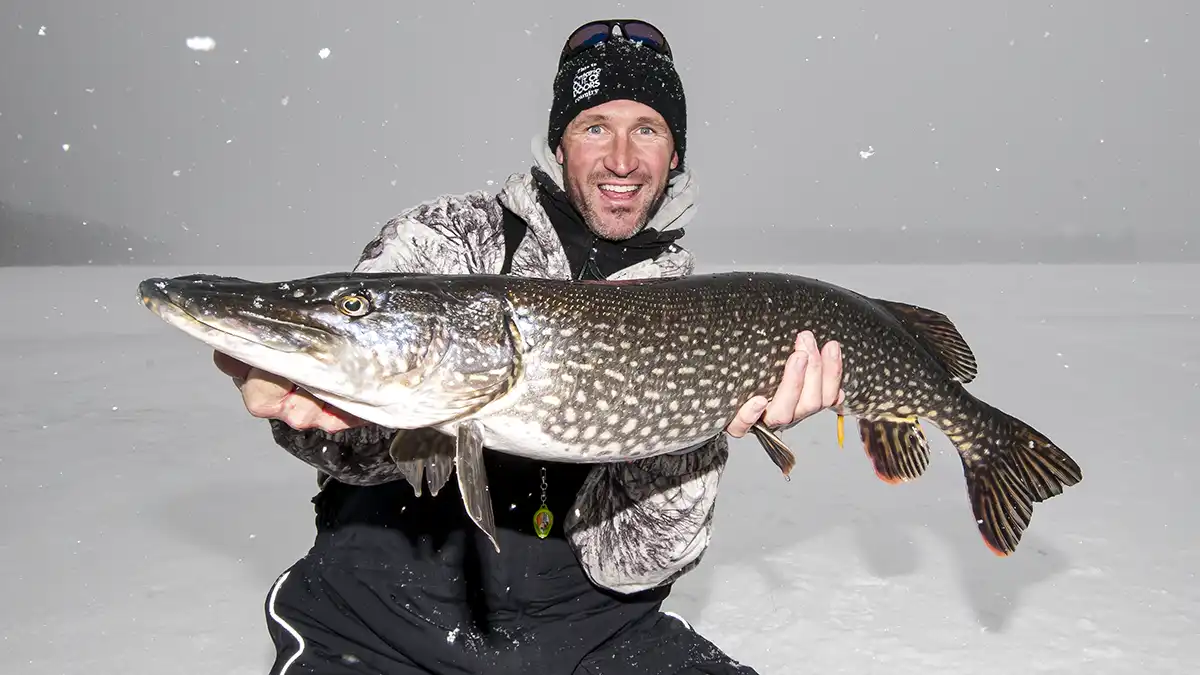
Popular Ice Fishing Species
Crappie, yellow perch and bluegills are all distinct species, but regularly share similar habitat. Common winter hangouts are bays with healthy vegetation, the base of a drop-off leading to a soft bottom, sand and mud flats as well as river backwaters.
Walleye remain fairly active in winter. In lakes containing healthy vegetation, look for walleye on shoreline points, in bays and on weed flats at first ice. In less fertile systems and during mid-winter, walleye frequently abide in 20 to 35 feet at mid-lake structures, such as humps, saddles, reefs, bars and flats.
Rainbow trout, brown trout, brook trout and lake trout offer good angling opportunities when found in lakes across the ice belt. Lake trout typically follow schools of baitfish around mid-lake humps and other structures within deep lake basins, but don’t overlook shallow areas close to deep water. Rainbows, browns and brook trout regularly relate to shorelines, bays and flats containing healthy vegetation and wood.
Northern pike are an aggressive predator. These fish follow their food. Shallow bays and mid-depth flats are productive early and late ice spots. In mid-winter, try deep flats, humps and other structures.
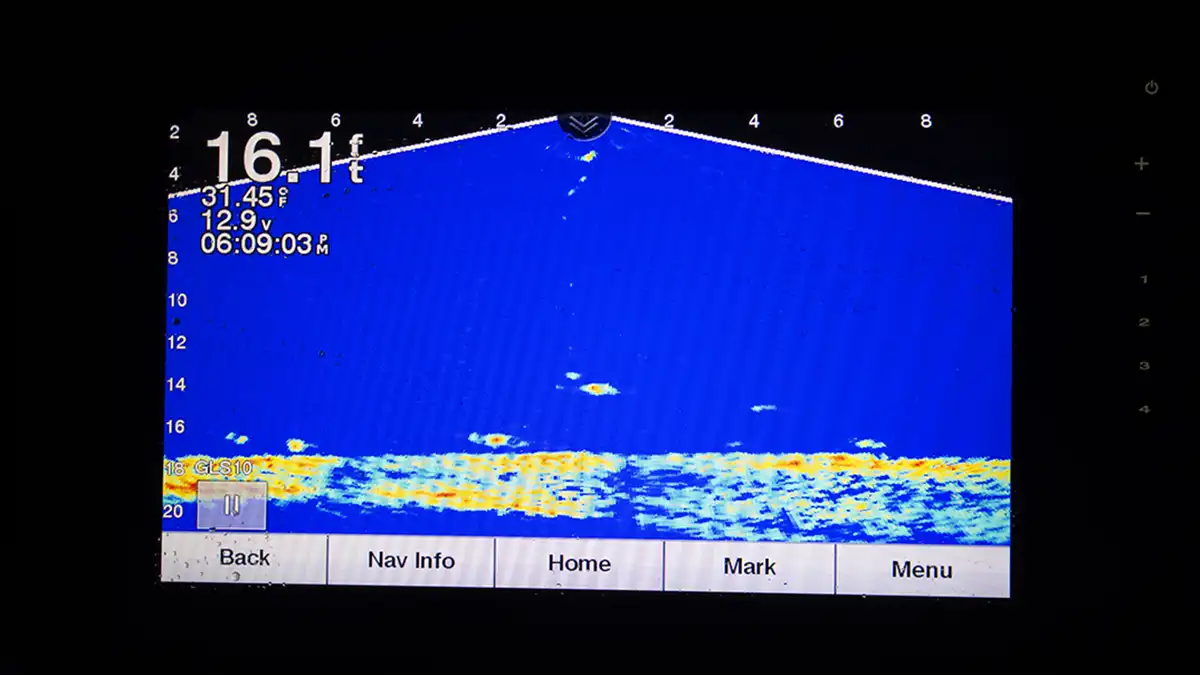
How to Find Fish While Ice Fishing
After locating the habitat of your target species, as described above, it’s time to start drilling holes and working the area. Drilling holes in a pattern keeps your search methodical. A zigzag or grid are two options worth trying.
Next, steadily jig each hole until you start catching fish and determine their location. As you become more advanced as an ice angler, you might not fish every hole. Sometimes dunking the sonar’s transducer and studying the display provides enough data to know to keep moving. For instance, if fish are relating tightly to a weed edge or the ledge of a hump, a hole too far away is likely not worth fishing.
How fast you fish and how long you stay in an area comes with experience, but avoid the pitfall of lingering too long when not catching fish. Generally, covering water is more productive than camping out on an unknown spot, waiting for fish to come to you.
Technology can help find fishing spots. Tools to use include smartphone apps and portable fish finder/GPS units with digital lake maps displaying depth contours and, ideally, some waypoints from past outings marking spots.
An underwater camera helps survey weeds and bottom details in clear water. When fishing shallow, you can learn a lot looking down an ice hole.
Ice Jigging Tactics
Jigging a bait with an ice fishing rod is perhaps the most popular way to ice fish. The basic ice fishing tips for cadence involve a lift-fall-pause sequence. But, the devil’s in the details, as they say, because you should always be experimenting with jigging specifics (speed, cadence, specific moves) as well as lure details (size, action, profile, color) to learn what fish like best.
Jigging must accomplish two things. Attract a fish, then trigger it to bite.
Some attraction moves include lure lifts and then drops of a foot or more, hard snaps of the rod tip and aggressive shakes mixed with pauses. Assuming you’re using a portable fish finder, the triggering game begins once you observe an interested fish approaching.
One option is continuing the same jigging cadence. This sometimes triggers aggressive and big fish.
Another strategy is toning down jigging moves. Shorter lifts, hops instead of hard snaps and gentle shakes, for example.
Adding pauses is critical. Stalling a bait presents a fish with a juicy bullseye they can hit easily, which also helps improve your hook-sets.
Ice Tip-Up Tactics
A tip-up is a standalone device, featuring a spool filled with tip-up fishing line and a trip mechanism, which causes a flag to pop up when a fish bites. Where ice fishing regulations permit more than one line per angler, a tip-up placed in a hole away from where you’re jigging helps cover water.
Rigging a live minnow on a jig or a single hook below a sinker on a 6- to 8-pound monofilament leader is a popular set-up for catching walleye and other species. Many hard-core ice anglers believe the best tactic for catching big pike is soaking a quick-strike rigged dead sucker, cisco or other baitfish beneath a tip-up. Typically, the bait is positioned within a few feet of bottom.
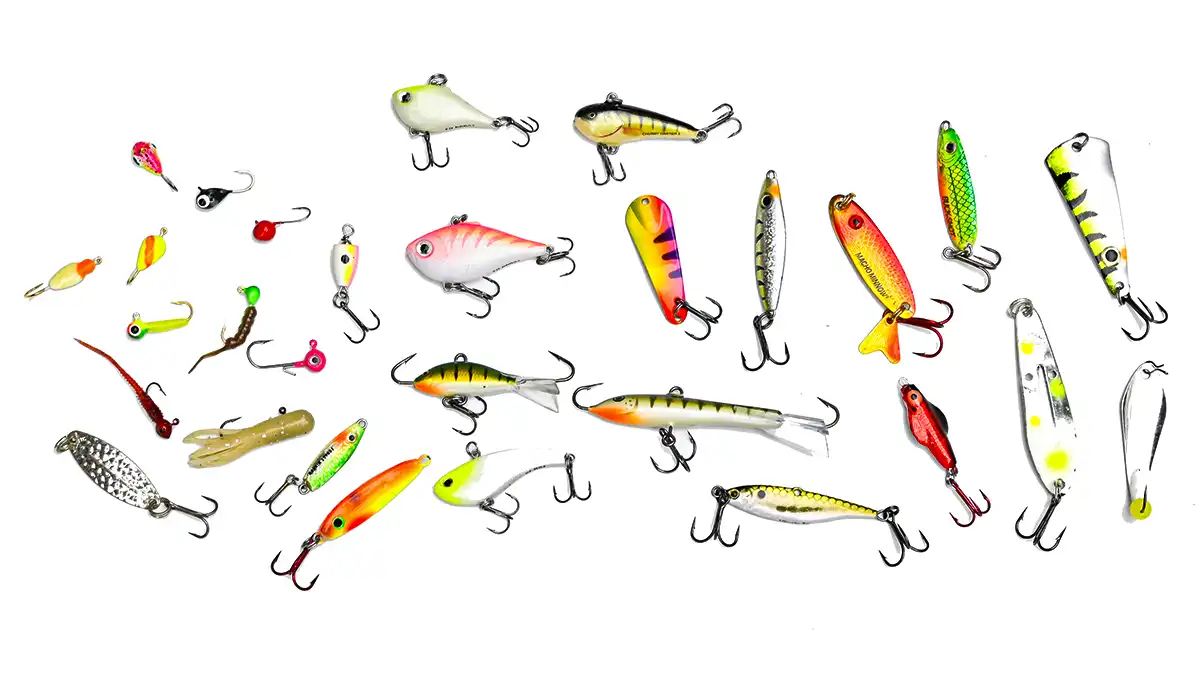
Best Ice Fishing Baits
You don’t need dozens of baits when starting out. Some variety is good, though, to be able to change presentations when troubleshooting how to get bites. Below are some lure categories to consider.
Tip: When selecting baits, think 1.5 inches or less for panfish and small trout, 1.5 to 2.5 inches for walleye and medium sized fish, and 3 inches and up for big predators. Generally speaking, of course.
Jigging Spoons
Spoons come in rattling and non-rattling models, as well as straight to curved shapes for different actions. Spoons catch fish on their own, but tipping one with a whole or a piece of minnow is deadly. Some to consider are: the 13 Fishing Flash Bang, Berkley Vibrato, Custom Jigs and Spins Slender Spoon, Freedom Minnow Jigging Spoon, PK Predator, Lindy Rattlin’ Flyer, Northland Buck-Shot Rattle Spoon, VMC Tumbler Spoon, and Williams Ice Jig.
Vertical Jigging Minnows
These baitfish lookalikes have a horizontal profile and natural gliding, swimming action fish find irresistible. The Rapala Jigging Rap is a classic example and extremely popular. Others are the ACME Hyper Glide, Clam Tikka Minnow, Freedom Turnback Shad, Moonshine Shiver Minnow, Rapala Jigging Shad Rap and Jigging Shadow Rap, and Northland Puppet Minnow.
Darters and Lipless Crankbaits
These baits produce decent vibrations when jigged, and have shimmying, gliding actions distinct from jigging minnows and spoons. Examples include the 13 Fishing Micro Magic Man, Live-Target Golden Shiner Rattlebait, Jackall TN60, Rapala Rippin’ Rap and Slab Rap, and Salmo Chubby Darter.
Jigs Rigged with Plastics or Live-Bait
There are many sizes and types of ice jigs available. A small tungsten or lead jig tipped with a few maggots is tough to beat for crappie and panfish. A jig and plastic with a worm, nymph, crayfish or other buggy profile are great for panfish and finessing various trout and walleye.
Tube jigs in various sizes catch everything from panfish to lake trout. A minnow soft-bait on a jig is another option, but, a real minnow nose-hooked on a jig is often too tempting for fish to ignore.
Ice fishing is a great way to spend time outdoors with family and friends during winter. Prioritize ice safety, dress in layers with warm clothes and apply the fundamental ice fishing tips described above, and you’ll be well on your way to catching plenty of fish this hard-water season.
EDITORS NOTE:
Tim Allard is a full-time outdoor journalist and author/photographer of the multi-award winning book, Ice Fishing – The Ultimate Guide. He has been described as one of the most influential fishing writers in Canada and is a multi-species, four-season angler.


